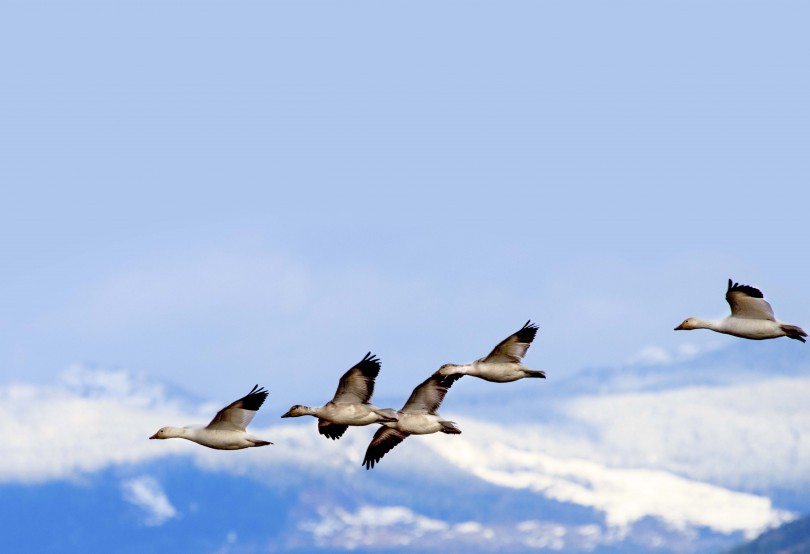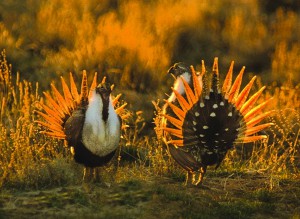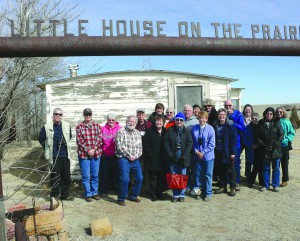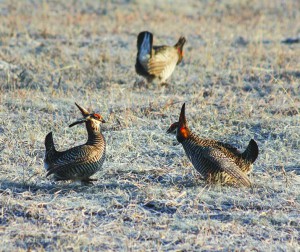By Malia Durbano, Photos by Josh Melby, Colorado District Wildlife Manager –
Watching the huge flocks of snow geese swirl down from the sky, amid a cacophony of honking, is a little like standing in a snow globe,” states the All About Birds website from Cornell University.
Bird enthusiasts are hoping to experience their own snow globe moment when they flock to the 14th annual High Plains Snow Goose Festival in Lamar for the free festival February 18 to 21.
Lamar in Prowers County is along an ancient corridor, designated the Central Flyway in 1948, that runs through the west-central section of the United States and includes Bent, Kiowa, Baca, Wray and Yuma counties in Colorado. Snow geese and other migrating birds, especially waterfowl, follow broad but well defined migration routes through the flyway each year.
The festival began in 2001 when John Koshak, Colorado Parks and Wildlife watchable wildlife coordinator, created the event to educate people about the snow geese that were already wintering in the area. He explains that the snow geese are called “spectacles” because they fly in such huge numbers that are spectacular to watch.
“Watching the huge numbers of birds take off from the lake at sunrise is an amazingly incredible sensory experience,” Koshak says. It is one that is worth sharing.
“We decided to do the festival at this time of year obviously because the birds are here, but also to stretch out the tourist season and help the local businesses. The huge flocks of birds provide entertainment here when nothing else is going on.”
Brighton residents Sally and Ron Harms attended the Snow Goose Festival numerous times over the past 10 years. The couple, who return every year the weather allows, enjoy seeing other regulars who attend. They all became friends through the years.
“Many couples enjoy participating in this hobby together,” Sally says. “They review notes and argue about which bird they are observing while comparing and adding to their Life Lists — something that serious birders maintain to record all the birds they have ever seen.”
Snow geese, the featured guests at the festival, were once dwindling in numbers, but recently skyrocketed to become among the most abundant waterfowl on the continent. Koshak further explains that the geese, that summer in the Arctic, began stopping in the lakes in southeastern Colorado rather than flying all the way to the Gulf. “And because the farmers stopped plowing under their fields, the surplus crops provide food for the migrating birds, whose numbers have doubled from three million in 2000 to almost six million now.”
Known for their beautiful white plumage, snow geese are found only in North America and make their annual round trip journey of more than 5,000 miles at speeds of 50 mph or more. The snow geese migrate in flocks that may number into the thousands or even tens of thousands. The spectacular sight of thousands of beautiful white birds often appears as a white cloud rising from the marsh.
Spring is not spring for many Colorado birders without a trip to Prowers County. Hot spots like Two Buttes, John Martin and Indian reservoirs, make it hard not to consider this place the epicenter of birding in the southeastern section of the state.
There are more than 494 species of birds in Colorado and 440 of them can be seen in Prowers County according to Koshak, who worked with Colorado Parks and Wildlife from 1997 until he retired in 2014. He has attended every Snow Goose Festival and explains that “birding,” the preferred term for bird watching, is one of the fastest growing recreational activities with over 70 million people participating.
Vince Gearhart, with the Lamar Chamber of Commerce, also loves to promote this annual festival and is excited to announce the first Snow Goose Festival photo contest. This year, the categories will be wildlife, landscape, birds and historical in two age groups.
Ron enjoys taking photos of the high plains, and he and Sally used to sell photos in a booth at the festival. Photography, like birding, helps you learn to focus on small things as opposed to looking at the big picture, Sally notes. “You learn to look and listen carefully wherever you happen to be.”
Everyone is hoping for amazing numbers of birds to focus on this year. “A few of the lakes in the area have more water than usual this year, which we hope will attract more birds,” Gearhart says. “It’s magnificent to see the huge flocks rise at sunrise in total chaos.”
The birds inhabit the fields during the day, and then spend the night in the reservoirs. In the morning, they take to the sky.
More than birding events
In addition to incredible opportunities to learn about and view birds out in exquisite scenery, attendees will enjoy abundant hospitality and stimulating conversation with fellow birding enthusiasts. Beautiful places like Painted Canyon, Carrizo Canyon and Cottonwood Canyon provide opportunities to also view bighorn sheep, elk, deer, eagles, hawks and ancient petroglyphs. Two Buttes Dam and Wildlife Area and Willow Creek Park are also popular birding areas in close proximity.
History buffs delight in the tour to the Amache Japanese Internment Camp, also called the Granada War Relocation Center, about 17 miles from Lamar, that housed Japanese-Americans during World War II.
Pat Palmer, organizing committee member, likes the idea of the Snow Goose Festival because “Lamar is one of the nicest places on earth. We were looking for a reason to bring people to the area to recreate and to enjoy themselves.” He appreciates viewing the approximately 450 species of birds that migrate through each year but he is more a historian than a birder.
Palmer will lead a tour to Bent’s Old Fort and Boggsville on Friday, February 19. The fort is a reconstructed 1840s adobe fur trading post used by the Bent brothers to trade blankets and rifles to the Indians in exchange for buffalo robes and beaver pelts. Flour, bacon and whiskey were also desirable commodities that changed hands.
The tour will feature re-enactments by various employees and volunteers dressed in period attire and portraying a blacksmith, a frontier doctor, a buffalo hunter and even Kit Carson, who is portrayed by his great-great-grandson, John Carson.
Frequent festival attendee Norma Verhoeff, amateur birder and photographer, excitedly recalls her captivation with the festival and its awesome speakers and authors of books on birding that she saw over the years. She even has autographs for her personal books.
Verhoeff has been interested in birds since her college ornithology classes. She maintains two big spreadsheets of all the birds she personally saw and a list of all the birds she and her husband observed on their 1,600 acre farm near the John Martin Reservoir.
In December, she and four girlfriends participated in the annual Christmas Bird Count organized by the Audubon Society. Now in its 116th year, the bird count is conducted between December 14 and January 5. Thousands of volunteers worldwide contribute to the early winter bird census by counting all the species they see in a 24-hour period within a 15-mile diameter circle. Verhoeff and her friends saw 100 species at the John Martin Reservoir, a location included in the Snow Goose Festival. These figures provide valuable data to the Audubon Society on bird numbers and migration routes.
Greater Prairie Chicken Tour
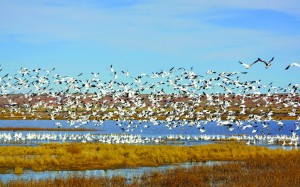 Of the 28 wildlife viewing festivals each year in Colorado, another favorite of Koshak’s is the Greater Prairie Chicken Tour, which he attended religiously for the past 24 years. It takes place in the small town of Wray in northeastern Colorado from Friday, March 25 to Sunday, April 17 in two-day segments. Koshak describes the prairie chicken mating festival as a really delightful, fun and endearing experience.
Of the 28 wildlife viewing festivals each year in Colorado, another favorite of Koshak’s is the Greater Prairie Chicken Tour, which he attended religiously for the past 24 years. It takes place in the small town of Wray in northeastern Colorado from Friday, March 25 to Sunday, April 17 in two-day segments. Koshak describes the prairie chicken mating festival as a really delightful, fun and endearing experience.
“Spectators go out at zero-dark-thirty, or about 4 a.m.,” Koshak explains. They sit in a blind so the birds can’t see them. The blind is a portable trailer with a roof and stadium seating that holds about 20 people. Ardith Hendrix, director of the Wray Museum, organizes nine tours throughout the season, providing the trailers that also provide warmth. “The spectators get there in the dark and wait for the males to walk onto the ‘lek,’ or area where they dance,” Hendrix explains. “The birds get very close to the trailer and are so used to it they sometimes dance on top of it.”
The males really work it, according to Koshak, strutting their stuff to attract a female. The entertaining males strut stomp, boom and cackle, as well as jump and bow — doing whatever it takes to attract a female. They are known for their elaborate courtship rituals and bright orange-colored air sacs that puff up as they fill them with air. When the air is squeezed out, it creates a popping, wheezing sound similar to the sound of blowing over the hole in a soda bottle.
The females arrive just before sunup and choose the most impressive male specimens. They go into the bush to mate, and the spectators adjourn to the hosting ranch for a scrumptious breakfast.
More Colorado birds
Many viewing festivals occur in the eastern section of the state because of the natural geographic features that birds find desirable — abundant wetlands and playa lakes, which are shallow seasonal wetlands. In Colorado, there are more than 2,500 playa wetlands that range in size from less than 1 acre to more than 50 acres.
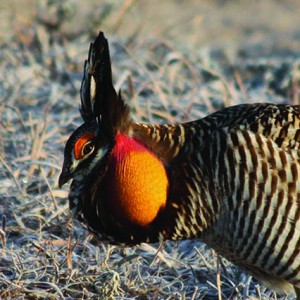 The playas are magnets for water birds that congregate in great numbers during migration, and some even stay all year long. Temporary visitors include plovers, sandpipers, cranes, egrets, gulls and grebes.
The playas are magnets for water birds that congregate in great numbers during migration, and some even stay all year long. Temporary visitors include plovers, sandpipers, cranes, egrets, gulls and grebes.
Koshak shares a story of a man from England who is number seven in the world for the longest Life List. The Brit has seen more than 7,000 species of birds and came to Colorado to add three more to his list. He came here to see rosyfinch prairie chicken and sage-grouse. The Gunnison sage-grouse was recognized as a new species of bird only 16 years ago and is only found in a small section of Colorado near Gunnison. People from all over the world will come to Sisk-a-dee, the viewing in April, to see one of the rarest North American birds.
Pueblo Eagle Day, on February 5, actually kicks off the season of festivals for wildlife viewing. Bighorn Sheep Day in Colorado Springs will be Saturday, February 13. One of the oldest wildlife festivals in the nation and an amazing spectacle to witness will occur near Monte Vista March 11–13 when the entire population of greater sandhill cranes, between 18,000 and 20,000 birds, stop for more than two months to load up on fuel on their way to their breeding grounds further north. Spectators can enjoy huge flocks dancing in the fields as they welcome spring during the Monte Vista Crane Festival.
Back in Colorado Springs on May 21, the city celebrates the return of hummingbirds with the North Cheyenne Cañon Hummingbird Experience.
And those are just the birding events during the first few months of the year. Get out your calendars, search the Internet and consider attending a festival or visiting an area mentioned here — and don’t forget your binoculars.
Malia Durbano is a freelance writer who taught and worked in many places before finding a new home base in Durango where she works, writes and watches for birds.

